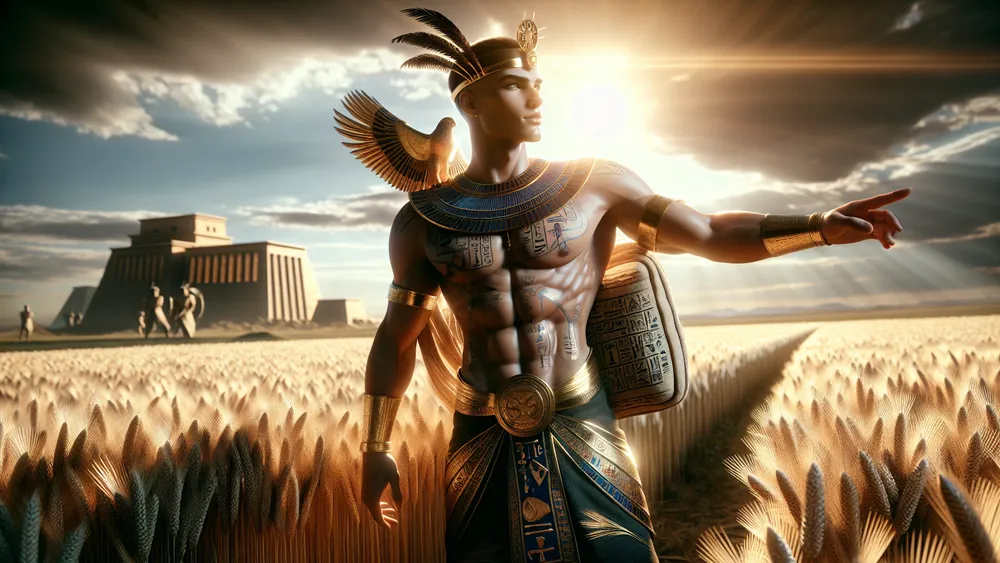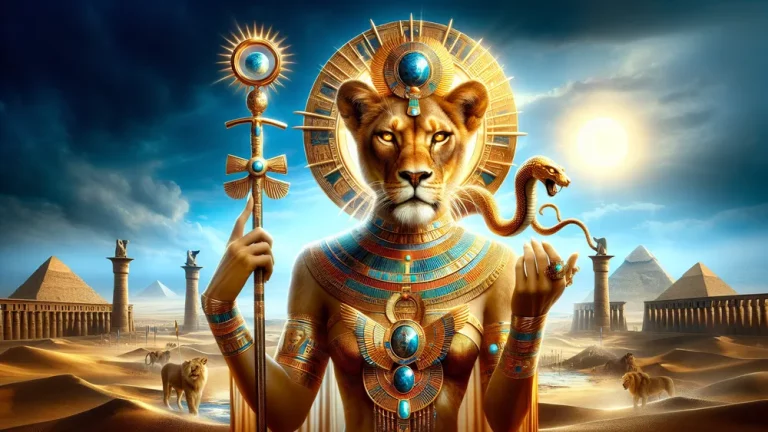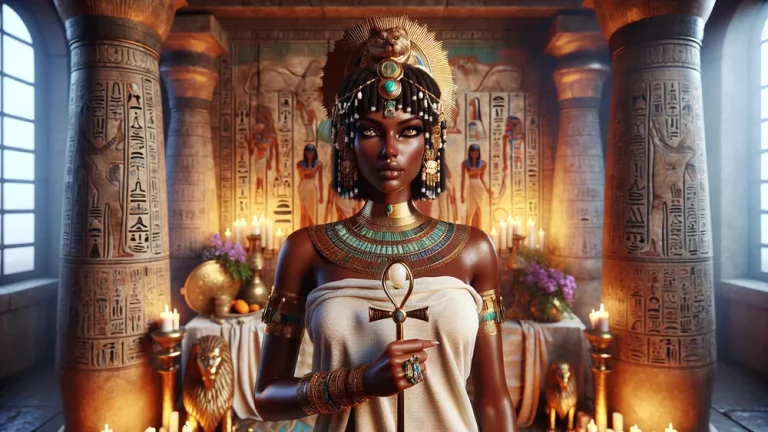Ancient Egyptian God Min: Fertility And Harvest Deity
Min, an ancient Egyptian god, plays a big role in their pantheon, especially when it comes to fertility and harvest. People have worshipped him since the pre-dynastic times, which means his importance lasted for thousands of years. This blog post dives into where Min comes from, his stories, and what he means to society.
Key Points:
- Min is an ancient Egyptian god linked to fertility and harvest.
- He symbolizes male strength and agricultural abundance.
- Min is often shown with a flail and an erect phallus in art.
- People worshipped Min for thousands of years for blessings on crops and fertility.
- Min’s mythology involves creation, fertility, and interactions with other gods like Isis and Osiris.
- Offerings to Min included lettuce, which symbolizes fertility, and rituals for agricultural success.
- Min’s legacy is seen in modern art, literature, and media, where he represents themes of fertility and creation.
We will look at how artists show him in their work, his connections with other gods, and how he still influences us today. By checking out historical sites, artifacts, and modern depictions, we aim to give you a full picture of Min’s many roles in ancient Egyptian religion and culture.
The Origins of Min
To really get why Min matters, we need to look at where his worship starts and what people believe about him. So, let’s dive into ancient Egyptian religious practices and see what’s special about Min.
Ancient Egyptian Beliefs and Worship
Ancient Egyptians have a rich tapestry of religious practices. They believe in many gods and goddesses, each with their own special roles. These deities are part of their daily lives. People perform rituals and give offerings to keep the gods happy and avoid bad luck. Min stands out as a fertility god. He symbolizes male strength and the ability to reproduce. But that’s not all. Min also helps with farming.
They believe he makes the land fertile and ensures good crops. So, they offer food, drink, and other items to get his blessings for both people and the fields.
- Polytheism: The belief in and worship of many gods.
- Rituals and Offerings: Essential practices to honor gods and seek their favor.
- Min’s Symbols: Often depicted with a flail and an erect phallus, symbolizing fertility.
- Agricultural Success: Min’s blessings were sought for abundant harvests.
Ancient Egyptians practice polytheism and perform rituals and offerings to honor and seek favor from gods, especially Min, who symbolizes fertility and agricultural success.
Mythology and Legends of Min
Min’s mythology is pretty fascinating. He pops up in ancient Egyptian creation myths, coming out of the primordial chaos and symbolizing the start of life and fertility. His birth and early stories put him among the first gods, often linked with Amon, which shows his big role in the pantheon. In popular legends, you see Min interacting with other gods like Isis and Osiris a lot.
These stories show him as a powerful figure who helps keep cosmic order and fertility in check. Min’s influence on human affairs is clear in many tales where he blesses people with fertility and makes sure crops thrive. This dual role as a god of both human and agricultural fertility really stands out.
- Min’s Birth: Often linked to the creation of life and fertility.
- Role in Pantheon: Associated with Amon, indicating high status.
- Interactions with Gods: Frequently involved with Isis and Osiris.
- Human Affairs: Blesses individuals with fertility and agricultural success.
Min’s mythology portrays him as a central figure in ancient Egyptian creation myths, symbolizing life and fertility, holding a key role in the pantheon and interacting with other major gods while influencing human and agricultural realms through blessings and prosperity.
Depiction and Attributes of Min
So, now that we’ve got a handle on Min’s mythology and legends, let’s dive into how he looks and what symbols are tied to him. You’re going to see some fascinating stuff!
Physical Representation and Iconography
Min usually shows up in ancient Egyptian art as a mummified man with an erect phallus. This symbolizes fertility and creation. He often holds a flail in his right hand, which stands for power and authority. You can see statues and carvings of Min wearing a headdress with two tall plumes. This really highlights his divine status.
In places like the Temple of Luxor and the Temple of Karnak, Min’s images are everywhere, integrated into the architecture. The artistic styles might change, but they always emphasize his role as a fertility god. They use symbolism like lettuce, which was considered an aphrodisiac back then.

- Temple of Luxor: Features numerous depictions of Min.
- Flail: Symbolizes power and authority.
- Headdress with Plumes: Indicates divine status.
- Lettuce Symbolism: Associated with fertility and aphrodisiac properties.
Symbols and Offerings Associated with Min
Min has some pretty interesting symbols tied to him, like lettuce, flail, and other items. You often see lettuce in his images because it’s thought to boost fertility and sexual energy. The flail, which he holds in his right hand, stands for power and authority. It shows he’s a protector of both agriculture and fertility. There’s also the bull, symbolizing strength and virility.
When it comes to offerings, people usually give fruits, vegetables, and bread during rituals for Min. These offerings are meant to get his blessings for good crops and fertility. They’re important because they connect to both farming success and human reproduction, showing Min’s dual role as a god of fertility and harvest.
| Symbol/Offering | Description | Significance |
|---|---|---|
| Lettuce | Depicts fertility and sexual potency | Considered an aphrodisiac |
| Flail | Held in Min’s right hand | Represents power and authority |
| Bull | Symbolizes strength and virility | Linked to Min’s protective role |
| Fruits, Vegetables, Bread | Common offerings in rituals | Ensures blessings on crops and fertility |
Min’s Role in Ancient Egyptian Society
So, now that we know about Min’s symbols and offerings, let’s see how he fits into ancient Egyptian life. He plays a big part in farming, fertility, and everyday practices.
Protector of Agriculture and Harvest
Min plays a huge role in farming practices in ancient Egypt. People believe he makes the land fertile and helps crops grow. Rituals for a good harvest are a big deal, and they often involve giving him fruits, vegetables, and bread. Farmers really depend on Min’s blessings to make sure their fields do well. They pray and hold ceremonies to get his favor, using things like lettuce because it symbolizes fertility.
Festivals, like the “Feast of the Ploughing Season,” are super important. During these times, there are processions, music, and dance, all aimed at getting Min’s protection for the fields and ensuring a good harvest.
- Feast of the Ploughing Season: A major festival where farmers seek Min’s blessings.
- Offerings of fruits, vegetables, and bread: Common items used in rituals to gain Min’s favor.
- Symbolism of lettuce: Used in ceremonies for its association with fertility.
- Processions, music, and dance: Activities during festivals to honor Min and seek his protection.
Farmers in ancient Egypt heavily rely on rituals and offerings to gain Min’s blessings for successful harvests, which are celebrated during festivals with processions and festivities.
Connection to Human Fertility and Reproduction
Min plays a big part in human fertility and reproduction in ancient Egypt. People often perform prayers and rituals to get his blessings, hoping it will help them have children. They might offer food, drink, and symbolic items like lettuce, which stands for fertility. Min’s blessings are also important for families, making sure kids are born healthy and strong.
During marriage ceremonies, they symbolically call on Min to bless the union and boost fertility. Couples give special prayers and gifts to Min, asking for his favor in having healthy kids. This shows how important Min is in both marriage and childbirth, where his influence is believed to help with having children and keeping family lines going.
- Lettuce as a fertility symbol: Often used in rituals to invoke Min’s blessings.
- Offerings of food and drink: Common items presented to Min during fertility rituals.
- Special prayers during weddings: Invoking Min’s favor for a fruitful marriage.
- Healthy offspring: A primary focus of prayers and offerings to Min.
Min’s Relationships with Other Egyptian Gods
To really get Min’s role in ancient Egypt, you have to look at how he interacts with other gods. These connections show just how important he is in the broader pantheon of deities.
Min and Isis
Min and Isis have a special connection in ancient Egyptian myths. You often see Min as a companion to Isis, who is the goddess of magic and motherhood. Their stories show how they work together, with Min focusing on fertility and Isis on nurturing. People worship them together in many temples, especially ones dedicated to both gods. These places have rituals that honor both, showing their combined power over fertility and farming.
Shared symbols and offerings like vegetation, especially lettuce, and ritual items are common in ceremonies for Min and Isis. This reflects how they both help ensure the land and people stay fertile.
- Temples like the Temple of Min at Koptos: Known for joint worship of Min and Isis.
- Rituals involving fertility rites: Often included offerings to both deities.
- Symbols like the ankh and flail: Commonly associated with both Min and Isis.
- Festivals celebrating agricultural cycles: Frequently honored both gods together.
Min and Isis have a strong connection in ancient Egyptian myths, with joint worship and rituals emphasizing their combined influence on fertility and farming.
Min and Osiris
Min and Osiris have a lot of mythological connections in ancient Egyptian beliefs. Osiris, the god of the afterlife and resurrection, often shows up in stories with Min. This pairing emphasizes themes of fertility and renewal. Min’s role as a fertility god fits well with Osiris’s link to rebirth. Together, they influence both the land’s productivity and the cycle of life and death.
People often worship them together in temples, focusing on agricultural prosperity and the afterlife. Shared symbols like the flail and the ankh come up in ceremonies to honor both gods. These symbols reflect their interconnected roles in ensuring the earth’s fertility and life’s continuation.

- Temple of Min at Koptos: Known for rituals involving both Min and Osiris.
- Annual festivals celebrating harvest: Often included offerings to both gods.
- Iconography featuring both deities: Common in temple reliefs and carvings.
- Ritual items like the djed pillar: Symbolizing stability and fertility, associated with both Min and Osiris.
Historical Sites and Artifacts Related to Min
To get a real feel for Min’s importance in ancient Egypt, let’s dive into the historical sites and artifacts dedicated to him. These places and objects give us a peek into how people venerated and depicted Min throughout history.
Temples and Shrines Dedicated to Min
Min has some pretty cool temples, especially in Koptos and Akhmim. These places aren’t just for worship; they’re also architectural marvels. You see grand columns, intricate carvings, and statues all dedicated to Min. The Temple of Min at Koptos stands out. It’s a big deal where they hold elaborate rituals and festivals to honor him. Besides these big ones, there are tons of smaller shrines all over Egypt.
These spots are super important for local folks. They go there to pray and make offerings, hoping for Min’s blessings on their crops and families. These shrines might be simpler in design, but they’re just as crucial in daily life.

- Temple of Min at Koptos: Known for its grand columns and intricate carvings.
- Temple of Min at Akhmim: Another major site with significant historical importance.
- Local shrines: Scattered across Egypt, serving community-specific religious needs.
- Architectural features: Grand columns, statues, and intricate carvings in major temples.
Pantheon of All the Egyptian Gods
The ancient Egyptian pantheon is huge, with tons of gods and goddesses, each having their own special roles and traits. If you want to dive deeper, check out this list of all the Egyptian gods. It gives you detailed info on the main deities people worshipped back then, their stories, and why they mattered so much in their culture.
FAQs
1. Who was Min in ancient Egyptian mythology?
Min in ancient Egyptian mythology was a god associated with fertility, harvest, and agricultural success.
2. What symbols are associated with Min?
Symbols associated with Min include the lettuce, the flail, and other items that represent fertility and agricultural abundance.
3. How was Min worshipped in ancient Egypt?
Min was worshipped in ancient Egypt through rituals, offerings, and festivals dedicated to invoking his blessings for fertility and agricultural success.
4. What is Min’s legacy in modern culture?
Min’s legacy in modern culture includes his influence on contemporary art, literature, and media, where he is often depicted and referenced.







